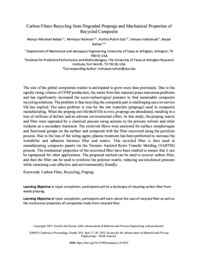
ATTENTION: The works hosted here are being migrated to a new repository that will consolidate resources, improve discoverability, and better show UTA's research impact on the global community. We will update authors as the migration progresses. Please see MavMatrix for more information.
Show simple item record
| dc.contributor.author | Rabby, Monjur Morshed | |
| dc.contributor.author | Rahman, Minhazur | |
| dc.contributor.author | Das, Partha Pratim | |
| dc.contributor.author | Vadlamudi, Vamsee | |
| dc.contributor.author | Raihan, Rassel | |
| dc.date.accessioned | 2023-06-14T01:37:05Z | |
| dc.date.available | 2023-06-14T01:37:05Z | |
| dc.date.issued | 2023-04-18 | |
| dc.identifier.citation | Rabby, Monjur Morshed, Minhazur Rahman, Das, Partha Pratim, Vamse Vadlamudi, and Rassel Raihan. "Carbon Fibers Recycling from Degraded Prepregs and Mechanical Properties of Recycled Composite," Copyright 2023. Used by the Society of the Advancement of Material and Process Engineering with permission. SAMPE Conference Proceedings. Seattle, WA, April 17–20, 2023. Society for the Advancement of Material and Process Engineering—North America. | |
| dc.identifier.uri | http://hdl.handle.net/10106/31204 | |
| dc.description.abstract | The size of the global composites market is anticipated to grow more than previously. Due to the rapidly rising volume of CFRP production, the waste from this material poses numerous problems and has significantly increased the socio-technological pressure to find sustainable composite recycling solutions. The problem is that recycling the composite part is challenging once its service life has expired. The same problem is true for the raw materials (prepregs) used in composite manufacturing. When the prepreg out-life/shelf-life is over, prepregs are abandoned, resulting in a loss of millions of dollars and an adverse environmental effect. In this study, the prepreg matrix and fiber were separated by a chemical process using acetone as the primary solvent and other oxidants as a secondary treatment. The retrieved fibers were analyzed for surface morphologies and functional groups on the surface and compared with the fiber recovered using the pyrolysis process. Due to the loss of the sizing agent, plasma treatment has been performed to increase the wettability and adhesion between fiber and matrix. This recycled fiber is then used in manufacturing composite panels via the Vacuum Assisted Resin Transfer Molding (VARTM) process. The mechanical properties of the recovered fiber have been studied to ensure that it can be repurposed for other applications. The proposed method can be used to recover carbon fiber, and then the fiber can be used to reinforce the polymer matrix, reducing sociotechnical pressure while remaining cost-effective and environmentally friendly. | en_US |
| dc.language.iso | en_US | en_US |
| dc.publisher | Society of the Advancement of Material and Process Engineering. SAMPE Conference Proceedings. Seattle, WA, April 17-20, 2023 | en_US |
| dc.relation.ispartofseries | ;TP23-0000000267 | |
| dc.subject | Research Subject Categories::TECHNOLOGY::Materials science | en_US |
| dc.subject | Carbon Fiber | en_US |
| dc.subject | Recycling | en_US |
| dc.subject | Prepreg | en_US |
| dc.title | Carbon Fibers Recycling from Degraded Prepregs and Mechanical Properties or Recycled Composite | en_US |
| dc.type | Article | en_US |
| dc.identifier.doi | https://doi.org/10.33599/nasampe/s.23.0267 | |
Files in this item
- Name:
- manuscript_seattle_prepreg.pdf
- Size:
- 1018.Kb
- Format:
- PDF
This item appears in the following Collection(s)
Show simple item record


